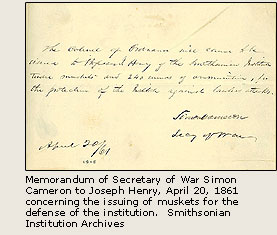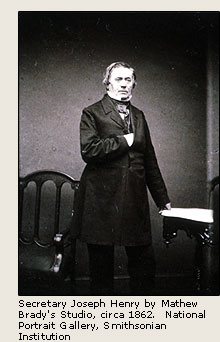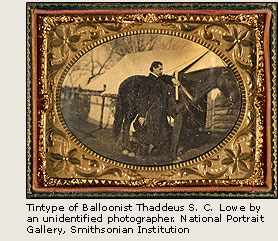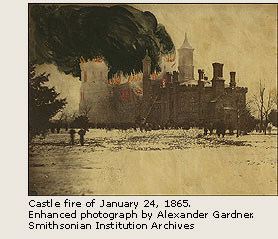  he
secession crises of 1861 and the Confederate bombardment of
Fort Sumter on April 12–13 had practical implications for
Joseph Henry and the Smithsonian, as it did for all of Washington.
On April 15, President Lincoln issued a proclamation declaring
that an insurrection had commenced. He called on the states
to send 75,000 volunteer militia to the unprotected capital.
Two days later in Alexandria a secession flag was hoisted atop
the Marshall House hotel in celebration of the Virginia state
convention in Richmond, which had just voted a referendum for
secession. This inauspicious flag was visible from the Castle
towers and the White House. On April 19, Southern firebrands
in Baltimore rioted when the 6th Massachusetts Volunteers, in
answer to Lincoln's call, passed through the city. Rebels cut
telegraph lines, isolating Washington from the North. For several
anxious days, residents and city authorities alike feared that
the capital would be attacked, “if not by the Southern
Confederacy,” wrote Joseph Henry, “by reckless filibusters,
who, taking advantage of a state of war, will endeavor to surprise
the city.” His opinion was reinforced by Secretary of War
Simon Cameron in a memo of April 20, informing Henry that the
colonel of ordnance would be issuing the Smithsonian 12 muskets
and 240 rounds of ammunition “for the protection of the
Institute against lawless attacks.” he
secession crises of 1861 and the Confederate bombardment of
Fort Sumter on April 12–13 had practical implications for
Joseph Henry and the Smithsonian, as it did for all of Washington.
On April 15, President Lincoln issued a proclamation declaring
that an insurrection had commenced. He called on the states
to send 75,000 volunteer militia to the unprotected capital.
Two days later in Alexandria a secession flag was hoisted atop
the Marshall House hotel in celebration of the Virginia state
convention in Richmond, which had just voted a referendum for
secession. This inauspicious flag was visible from the Castle
towers and the White House. On April 19, Southern firebrands
in Baltimore rioted when the 6th Massachusetts Volunteers, in
answer to Lincoln's call, passed through the city. Rebels cut
telegraph lines, isolating Washington from the North. For several
anxious days, residents and city authorities alike feared that
the capital would be attacked, “if not by the Southern
Confederacy,” wrote Joseph Henry, “by reckless filibusters,
who, taking advantage of a state of war, will endeavor to surprise
the city.” His opinion was reinforced by Secretary of War
Simon Cameron in a memo of April 20, informing Henry that the
colonel of ordnance would be issuing the Smithsonian 12 muskets
and 240 rounds of ammunition “for the protection of the
Institute against lawless attacks.”
 From
the beginning, Joseph Henry was confronted with the exigencies
of war. As a scientist, he had emphasized the need for the
institution to be apolitical and autonomous of government
interference. To demonstrate the institution's neutrality,
Henry did not fly the American flag over the Castle during
the conflict. He was criticized for this, and his patriotism
was questioned by some, but never by President Lincoln or
his administration. Henry believed that in the event of a
hostile attack, the institution might fare better if it flew
no colors at all, especially during that precarious spring
of 1861. Ironically, Henry’s immediate concern was not fending
off attacking Southerners, but coping with the influx of Yankees
seeking quarters in such public buildings as the Capitol and
the Patent Office. When authorities suggested the Smithsonian
as a temporary barracks, Henry argued instead that its use
as an infirmary would be “more in accordance with the
spirit of the Institution.” The War Department respected
his wishes and did not impose upon the institution. Still,
Henry proved to be a valuable asset to the administration.
He and President Lincoln personally liked and admired the
talents of the other, although their political philosophies
differed significantly about the wisdom of resorting to arms.
Henry believed that war was a mistake and that it would not
necessarily lead to a reconciliation between North and South.
Nevertheless, he placed himself and the institution at the
service of federal authorities whenever science could lend
a hand to the war effort. From
the beginning, Joseph Henry was confronted with the exigencies
of war. As a scientist, he had emphasized the need for the
institution to be apolitical and autonomous of government
interference. To demonstrate the institution's neutrality,
Henry did not fly the American flag over the Castle during
the conflict. He was criticized for this, and his patriotism
was questioned by some, but never by President Lincoln or
his administration. Henry believed that in the event of a
hostile attack, the institution might fare better if it flew
no colors at all, especially during that precarious spring
of 1861. Ironically, Henry’s immediate concern was not fending
off attacking Southerners, but coping with the influx of Yankees
seeking quarters in such public buildings as the Capitol and
the Patent Office. When authorities suggested the Smithsonian
as a temporary barracks, Henry argued instead that its use
as an infirmary would be “more in accordance with the
spirit of the Institution.” The War Department respected
his wishes and did not impose upon the institution. Still,
Henry proved to be a valuable asset to the administration.
He and President Lincoln personally liked and admired the
talents of the other, although their political philosophies
differed significantly about the wisdom of resorting to arms.
Henry believed that war was a mistake and that it would not
necessarily lead to a reconciliation between North and South.
Nevertheless, he placed himself and the institution at the
service of federal authorities whenever science could lend
a hand to the war effort.
 In
June 1861, aeronaut Thaddeus S. C. Lowe brought his balloon
to the Smithsonian for Henry's inspection and to make an ascent
to test the use of telegraphing from the air to the ground.
Henry supported Lowe's efforts to provide the Union army with
aerial reconnaissance. Likewise, he cooperated with Albert
J. Myer, the army's first chief of the signal corps, in testing
a system of lantern signals at night from the Castle’s highest
tower. In February 1862, Henry was named to a three-member
navy advisory commission to assist the government in assessing
such new scientific innovations as the design of ironclad
ships and new weapons. The board’s formal evaluations on hundreds
of proposals, many of them impractical, saved the government
from spending money on bad inventions. In
June 1861, aeronaut Thaddeus S. C. Lowe brought his balloon
to the Smithsonian for Henry's inspection and to make an ascent
to test the use of telegraphing from the air to the ground.
Henry supported Lowe's efforts to provide the Union army with
aerial reconnaissance. Likewise, he cooperated with Albert
J. Myer, the army's first chief of the signal corps, in testing
a system of lantern signals at night from the Castle’s highest
tower. In February 1862, Henry was named to a three-member
navy advisory commission to assist the government in assessing
such new scientific innovations as the design of ironclad
ships and new weapons. The board’s formal evaluations on hundreds
of proposals, many of them impractical, saved the government
from spending money on bad inventions.
 Throughout
the conflict, the Smithsonian would experience what Henry
called “interruptions” of its own programs. One
of Henry's first scientific endeavors as secretary was to
establish a national network of volunteer weather observers,
who would send monthly reports to the Smithsonian by mail
or telegraph. The war largely interfered with these means
of communication, especially hindering news from the South
and West. There would be other interruptions for sure, but
no event was as devastating as the Castle fire on January
24, 1865. An improperly installed stovepipe caused the fire,
which did extensive damage to the building and collections.
Worse still, most of the Smithsonian’s early records were
reduced to ashes. The building would be restored, and within
days the military had constructed a temporary roof. Yet the
bulk of Henry’s letters, some 85,000 pages, would be mostly
irretrievable. “In the space of an hour was thus destroyed
the labor of years,” wrote Mary Henry in her diary of
her father’s loss. Mary went on to record how the letters
had been “written with great care & were in answer
to questions upon almost every subject. . . . It is next to
losing Father to have them go.” Throughout
the conflict, the Smithsonian would experience what Henry
called “interruptions” of its own programs. One
of Henry's first scientific endeavors as secretary was to
establish a national network of volunteer weather observers,
who would send monthly reports to the Smithsonian by mail
or telegraph. The war largely interfered with these means
of communication, especially hindering news from the South
and West. There would be other interruptions for sure, but
no event was as devastating as the Castle fire on January
24, 1865. An improperly installed stovepipe caused the fire,
which did extensive damage to the building and collections.
Worse still, most of the Smithsonian’s early records were
reduced to ashes. The building would be restored, and within
days the military had constructed a temporary roof. Yet the
bulk of Henry’s letters, some 85,000 pages, would be mostly
irretrievable. “In the space of an hour was thus destroyed
the labor of years,” wrote Mary Henry in her diary of
her father’s loss. Mary went on to record how the letters
had been “written with great care & were in answer
to questions upon almost every subject. . . . It is next to
losing Father to have them go.”

|